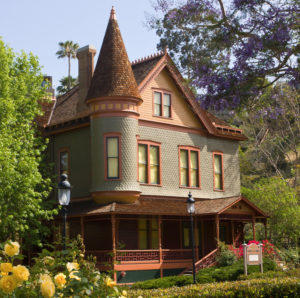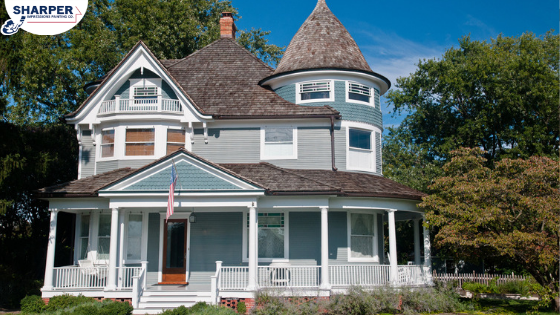While many homeowners want to move into newer “turn key” homes, still others love the charm of older, historic homes. Historic homes often have architectural details, woodwork and features newer homes don’t. And while they might come with their own set of problems and updates, older homes tend to carry a different type of warmth and coziness than newer homes.
When it comes to painting historic homes, it can be tricky to get the right paint color, especially if you’re trying to stay in keeping with the home’s style. It’s tempting to want to “update” the home with a modern color. But we’ve found that many times, trendy paint colors tend to not look right in an older home. This isn’t to say you can’t use modern, fresh versions of historically accurate colors…we’ve just seen trendy colors go wrong enough times to caution against them.
Best Paint Colors for Historic Homes
So what paint colors are best for the interior and exterior of a historic home? Here are some of our favorites.
Mint
While we are seeing a resurgence of this light green in the last few years, mint is actually a color that was used often around the turn of the 20th century. It also saw a return in the 50’s and 60’s as a staple color in Midcentury modern design, so it is a great color for both stately Victorians and streamlined ranches. Mint looks great against both painted and stained trim and is the perfect backdrop for metallic accents.
To keep mint looking fresh in your older home, find one that doesn’t have too much green or yellow in it, which can start to skew “avocado” (which is one color we’re still trying to forget). Try mint in your historic home’s kitchen or in the master bedroom or living room.
Best Mint Paint Colors for Older Homes:
Mint Wafer: a light mint that looks great with gold or brass accents
Dinner Mint: mint with emerald green that makes glossy white or cream trim sing
Chilled Mint: a soft mint that looks cool in kitchens or living rooms
Red

Red paint colors can have an earthy feel and represent strength, power and energy. All of which can complement the elegant look of an older home.
Our Favorite Red Paint Colors for Historic Homes:
Mesa Red: rusty red that is perfect for a warm-hearth feel in dining room or kitchen
Hunt Club Red: dark ginger red that looks great on a stone fireplace wall
Blaze: dark, spiced red that can make a statement as a front door or window trim
Yellow
Believe it or not, yellow is a historical paint color! In fact, it can be found in dining rooms from several hundred years ago, and can also be a great exterior paint color for older homes. Be careful, though: yellow can easily become too bright or too washed out if you don’t find the right tone.
Bright yellows with mustard undertones are experiencing a resurgence and also work well as a paint color in historic homes. They tend to pair best with white trim or white painted woodwork or wainscoting. Darker wood can make even the perfect yellow look old and dated, but the right yellow-and-white combo looks timeless. Yellow also looks great in a variety of historic homes, including Victorian, Craftsman or a Midcentury ranch.
Timeless Yellow Paint Colors for Historic Homes:
Acorn Squash: Use this bright yellow in rooms with lots of tall painted trim or wainscoting so it looks sunny but not overpowering.
Be Daring: this yellow has buttery undertones and would look perfect in a dining nook
Grass Daisy: this deep, warm yellow would be at home in a Craftsman or Amercian Foursquare, and could even be a good exterior paint color in the right neighborhood
Navy
Navy is a classic paint color for older homes for a reason. It can easily fade into the background to provide the perfect backdrop for antique furniture, or it can be a showstopping color, depending on the natural light, the trim and the room itself. Don’t go too “blue” with navy, however, or you’ll very quickly have a room that feels unintentionally nautical. Instead, find a deep, rich navy that has either black or gray undertones. These undertones keep the color saturated without allowing it to overwhelm the space.
Navy is both a great interior and exterior historic home paint color. It pairs well with both darker woodwork and trim or looks fresh and clean against white trim. We like seeing navy in libraries and studies, family rooms or even smaller guest rooms or half baths.
Our Favorite Navy Paint Colors for Older Homes:
Rich Navy: a true neutral classic and looks beautiful in any room or on a historic home’s exterior
Sophisticated Navy: this navy has a bit of earthiness to it, making it perfect for a study or smaller half-bath or pantry
Brigade: this brighter, lighter navy works well in a kitchen or in rooms with gold accents. It’s also great on exterior trim and doors.
Light Blue

Like navy, light blue looks lovely against just about any color of trim. It can also make smaller bedrooms feel more open and airy. Watch, though, that the light blue you choose for your historic home isn’t too saturated…you’ll end up looking like you’ve painted for a baby boy’s room rather than your traditional foyer. But the right light blue paint color can make your historic home stand out for all the right reasons.
Best Light Blue Paint Colors for Historic Homes:
Keepsakes: a light blue with indigo undertones, good for bedrooms and bathrooms
Mirror, Mirror: a soft gray-blue that looks stunning on a historic home’s exterior
Haunting Blue: a light pure blue that makes wood accents, painted trim or beautifully curated antiques take center stage.
Greige
Craftsman homes are often awash in warm beige tones. And while that color was very much in keeping with the times, beige tends to yellow or look dull over time. That’s why greige tends to be the perfect modern twist on the warmer beiges of the past.
You can still go with a greige that has warm undertones if you’re worried you’ll be out of keeping with your home’s original decade. But even these warmer toned greige paint colors will feel fresh without overpowering your space. Greige is also great if you’re not ready to go all-in with color in your historic home, but still want to highlight trim, woodwork or antiques. We like greige in bedrooms and living rooms, and it always looks beautiful on a historic home’s exterior, especially if you highlight trim in another color.
Best Greige Paint Colors for Historic Homes:
Stonington: a warm-neutral greige that makes warmer woods shine
Moth Grey: midtoned golden greige that helps highlight exterior trim and architectural details
Stonehenge Greige: a saturated golden greige, Stonehenge Greige is our perennial favorite for both interior and exterior painted surfaces. We haven’t found a historic home yet that doesn’t look good in Stonehenge
If you’re still not sure about what color to paint the interior or exterior of your historic home, do a little research on colors your type of home typically had when it was originally built. You can also consult with your town or city’s historical society, who might have ideas or references for you.
If you’re still stuck, check with a reputable professional paint company. Many of them will provide a free color consultation and a free painting quote, as well. Plus, many companies will have worked on historic homes in the past and will have knowledge about the best paint colors to use and the right paint techniques for your older home.
Get Expert Help Painting the Interior or Exterior of Your Historic Home
Our professional paint experts are ready to paint the interior or exterior of your historic home! We’ve worked with many clients to determine the right colors for their historic home’s era and style. Contact us today for a free painting quote for your historic home.

